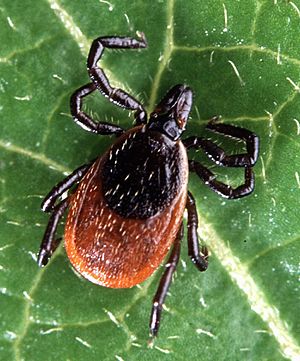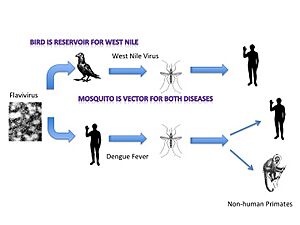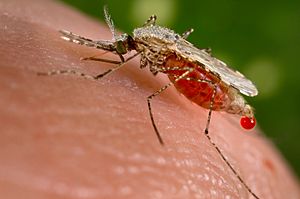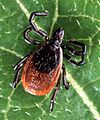Vector (biology) facts for kids
A disease vector is a living thing that carries and spreads germs (called pathogens) from one living organism to another. Think of them as tiny delivery systems for diseases! These vectors are often small creatures like parasites or microbes.
The idea of disease vectors was first really understood in 1897. A scientist named Ronald Ross discovered that mosquitoes were carrying the germs that cause malaria. He found this out by carefully studying a mosquito. Many things can affect how much vector-borne diseases spread, including the animals that carry the disease, the vectors themselves, and people.
Contents
Insects: Tiny Disease Carriers

Many insects are known to spread a lot of different germs. These include Mosquitoes, flies, sand flies, lice, fleas, ticks, and mites. A lot of these insects need to feed on blood at some point in their lives. When they bite and feed on blood, the germs can enter the host's body. This can happen in different ways.
Mosquitoes and Malaria
The Anopheles mosquito is a famous vector. It spreads diseases like malaria, filariasis, and various arboviruses. When this mosquito bites you, it puts its tiny mouthpart under your skin to drink blood. If it carries germs, these germs are then passed directly into your bloodstream from its salivary glands.
Triatomine Bugs and Chagas Disease
Triatomine bugs are responsible for spreading a parasite called Trypanosoma cruzi. This parasite causes a serious illness known as Chagas disease. These bugs often poop while they are feeding. Their poop contains the parasites. If you scratch the bite, you might accidentally rub the infected poop into the open wound, letting the parasites enter your body.
Mammals: Spreading Rabies
Rabies is a very serious disease that can be spread through the saliva or brain tissue of an infected animal. Any warm-blooded animal can carry rabies. However, the most common animals that spread rabies are dogs, skunks, raccoons, and bats.
How the World Health Organization Helps
The World Health Organization (WHO) is a global group that works to improve health. They focus on controlling and preventing diseases spread by vectors. They use something called "Integrated Vector Management (IVM)". This approach looks at how health and the environment are connected. It tries to find the best ways to protect both.
In April 2014, the WHO started a campaign called “Small bite, big threat.” This campaign aimed to teach people about illnesses spread by vectors. The WHO reported that these illnesses often affect people who are poor. This is especially true for those living in areas without good sanitation, clean drinking water, or proper housing.
Humans as Vectors

Recent reports show that human activities can also help spread diseases. These are often zoonotic diseases, meaning they can spread between animals and humans.
Some examples of these diseases include:
There are also tiny insects called Thrips that can spread over 20 different viruses, especially Tospoviruses. These viruses cause many kinds of plant diseases.
Even humans can act as vectors for some plant diseases, like the Tobacco mosaic virus. People can physically carry the virus on their hands from one plant to another, spreading the infection.
Images for kids
See also
 In Spanish: Vector (desambiguación) para niños
In Spanish: Vector (desambiguación) para niños





